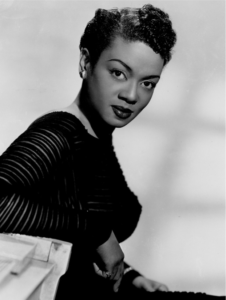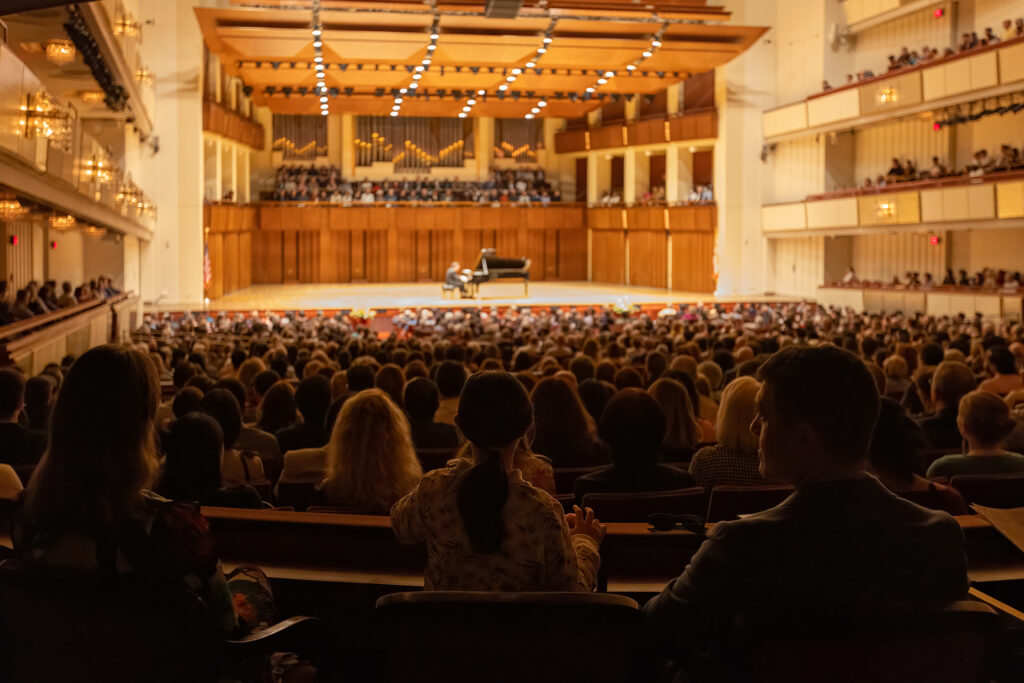Sounds of Hazel
Sounds of Hazel
Dance Theatre of Harlem
Virginia Johnson, artistic director
Season opener! DTH returns to Washington Performing Arts with the world-premiere performances of a new ballet honoring American music icon Hazel Scott, plus Higher Ground scored with Stevie Wonder’s Motown hits.
We are honored and delighted to launch our 2022/23 Season with the illustrious Dance Theatre of Harlem (DTH), a frequent collaborator whose very first D.C. performance Washington Performing Arts presented in 1973.
In this special three-performance engagement at Sidney Harman Hall, DTH stages their acclaimed Higher Ground, a 2021 social commentary set to Stevie Wonder’s Motown hits. The piece mixes neoclassical dancing with contemporary African-American social dancing, as choreographed by Dance Theatre of Harlem’s resident choreographer Robert Garland.
For the second half of the program, DTH presents the world-premiere ballet, Sounds of Hazel, co-commissioned by Washington Performing Arts, and inspired by the life and work of Hazel Scott—the prodigiously gifted Trinidadian-American jazz and classical pianist, bandleader, recording artist, and star of stage and screen. Scott, also known for her fervent civil rights activism, suffered persecution at the height of her fame amid the hysteria of McCarthyism. DTH founding member and artistic director Virginia Johnson, choreographer Tiffany Rea-Fisher, and composer Erica Lewis-Blunt spearhead the Sounds of Hazel creative team.
In Rea-Fisher’s words: “Hazel Scott was a diva with a capital ‘D,’ but she was also super-grounded. She was not afraid to be raw and rough while also being glamorous. Her erasure from history was intentional because she was so audacious. People actively tried to erase her…so to be able to not only not erase her but celebrate her for all that she is and was is really super-super exciting.”
Presented in partnership with CityDance.
Program Details
Born in Port of Spain, Trinidad on June 11, 1920, Hazel Scott was the only child of R. Thomas Scott, a West African scholar from Liverpool, England and Alma Long Scott, a concert pianist and music teacher. A precocious child who discovered the piano at the age of three, Hazel surprised everyone with her ability to play by ear. Once the family migrated to the States, Alma secured an audition for her daughter at the prestigious Juilliard School of Music. Though the entry age of admission was 16, Hazel’s prodigious gifts prompted school administrators to make special arrangements for her to begin rigorous study in piano performance.
After playing gigs around her Harlem neighborhood, winning a competition to host her own radio show at 14 years old, and making her Broadway debut by 18, it was her appearance at New York City’s first integrated nightclub, Café Society, (at the insistence of family friend and mentor, Billie Holiday) that would be the catalyst for her meteoric rise in the entertainment industry. Wowing audiences with her swing renditions of classical masterpieces by Chopin, Bach and Rachmaninoff, Hazel Scott soon became known as the “Darling of Café Society.”
There was little separation between Hazel’s concert performances and her outspoken politics. She attributed it to being raised by very proud, strong-willed, independent-minded women. She was one of the first black entertainers to refuse to play before segregated audiences. Written in all her contracts was a standing clause that required forfeiture if there was a dividing line between the races. “Why would anyone come to hear me, a Negro, and refuse to sit beside someone just like me?”
By the time Hollywood came calling, Hazel had achieved such stature that she could successfully challenge the studios’ treatment of Black actors, demanding pay commensurate with her white counterparts, and refusing to play the subservient roles in which black actors were commonly cast. She would wear no maid uniforms or washerwoman rags, insisting that her name credit appear the same in every film: “Hazel Scott as Herself.” She performed in five major motion pictures in the early 1940s, including I Dood It, directed by Vincente Minnelli and featuring Lena Horne; The Heat’s On, starring Mae West; and the George Gershwin biopic, Rhapsody in Blue.
It was during these peak years of her career that Hazel began a romantic affair with the crusading Harlem preacher and politician, Adam Clayton Powell, Jr., who was making a bid for the U.S Congress. The couple married in August of 1945. After giving birth to their son, Adam C. Powell III, Hazel settled into domestic life in upstate New York, putting her career on the backburner to fulfill her duties as political wife, first lady of Abyssinian Baptist Church, and mother—the role she loved most of all.
More about the Artist
Dance Theatre of Harlem Artistic Director Virginia Johnson and choreographer Tiffany Rae-Fisher share the process of bringing the world-premiere ballet Sounds of Hazel to the stage.
Dance Theatre of Harlem is a frequent collaborator with Washington Performing Arts since 1973. What inspired the idea for Sounds of Hazel, and how has the process come together?
Virginia: As you note, [Washington Performing Arts] has been an important partner to Dance Theatre of Harlem for nearly 50 years, so we have often had conversations about possible collaborations. It was back in 2018 when Jenny Bilfield mentioned that the centenary of Hazel Scott’s birth was coming up in 2020 and asked if DTH was interested in creating a ballet about her. I confess that I knew nothing about Hazel Scott, but after reading Karen Chilton’s excellent biography of Scott, I knew that this was an important project to take on. Tiffany Rae-Fisher (choreography) was in the midst of creating the work when the pandemic hit. The gestation for Sounds of Hazel has been exceptionally long, but I am thrilled that the ballet will premiere at the Harman in October.
How would you describe what audiences will experience when seeing the ballet?
Tiffany: This work explores different eras of Scott’s career and follows her worldwide travels, often as a trailblazer and sometimes under duress. Her achievements as an artist and cultural innovator were joyous and rich, so I’ve strived to imbue this piece with the same complexity and energy that ran through her life.
How has this world-premiere ballet evolved through the workshop process to what audiences will see on stage?
Tiffany: We began with the intention of creating something slightly more abstract to capture the greater impact of Hazel’s legacy, but quickly realized that her boldness demanded more specific representation. She was such
a magnetic presence that it seemed foolish not to capitalize on her unique personality and let her be the lead of her own story.
Why is it important to you that we commemorate Hazel Scott, her impact on American music, and her activism?
Virginia: As a Black person building a future for herself in mid-century America, Hazel Scott accepted no limits but created space for her talent to flourish. Hers is an inspiring story that needs to be brought back into American consciousness.
What is special to you about presenting this world-premiere in D.C. this fall? Why is this work especially resonant now?
Virginia: I am so happy that this work will finally have its premiere! It is important to me to revitalize a connection to Hazel Scott as an artist who would not be diminished, who was also an activist who was not afraid to stand up for what was right. She is a role model that more people need to know about.
Tiffany: Our goal is to leave viewers energized to learn more about Scott on their own and to be inspired by her example to become ever more outspoken advocates in their own lives. Hazel was never shy about celebrating her voice and, even today, sets the standard for what a combination of confidence and excellence can achieve.
 WHO IS HAZEL SCOTT?
WHO IS HAZEL SCOTT?
by Karen Chilton
In July of 1950, Hazel was offered an unprecedented opportunity by the DuMont network to have her own TV show, becoming the first Black American performer with a nationally syndicated program. Without variety acts, Hazel was the solo star of the show, performing piano and vocals, often singing tunes in one of the seven languages she spoke, with a rhythm section that included bassist Charles Mingus and drummer Max Roach.
But before she could fully enjoy her groundbreaking achievement, her name would appear on the blacklist of suspected communists during the McCarthy Era. Due to her civil rights activism, she became a target of the House Un- American Activities Committee (HUAC). After requesting a hearing to clear her name, the government’s suspicions were enough to put a halt to her career. The Hazel Scott Show was canceled, and concert bookings dried up. Around the same time, after eleven years of marriage, Hazel and Adam decided to part ways. With her young son in tow, she joined the burgeoning black expatriate community in Paris.
After a decade of living abroad, she would return to an American music scene that no longer valued what she had to offer. Once the “Darling of Café Society,” Hazel continued to perform, playing small clubs to a devoted fan base, perfecting her style and constantly exploring new ways of expressing herself, musically.
In October of 1981, Hazel Scott died of pancreatic cancer. Her musical contributions span many decades, and though she is not as widely recognized as some of her contemporaries, her extraordinary contributions are now experiencing a resurgence of interest and enthusiasm. Her legacy lives on as a brilliant American artist, entertainer, and advocate for civil rights.
Karen Chilton is author of Hazel Scott: The Pioneering Journey of a Jazz Pianist from Café Society to Hollywood to HUAC, University of Michigan Press.
Our Partners
Washington Performing Arts’s Hazel Scott 102nd Birthday Celebration is supported in part by the National Endowment for the Arts, Lydia Micheaux Marshall, Dr. Gary Mather and Ms. Christina Co Mather, Barbara Myers and Tom Gallagher, Adam Clayton Powell III and Irene M. Solet, and Jenny Bilfield and Joel Phillip Friedman
Special thanks to the following lead supporters of Washington Performing Arts’s mission-driven work: Jacqueline Badger Mars and Mars, Incorporated; the National Capital Arts and Cultural Affairs Program and the U.S. Commission of Fine Arts; D.C. Commission on the Arts and Humanities; and the Dallas Morse Coors Foundation for the Performing Arts.

Become A Friend
Your support funds the wide-ranging artistic work that inspires, educates, and connects us.


